Posted by Michael Haran on May 28, 2014

Chris Rogers signs-in volunteers
On the Saturday before the Super Bowl we all met at the Carpenter’s Hall on Lindaro Street in San Rafael. We were there, all 42 of us, volunteers to walk and talk and to introduce Marin voters to Mike McGuire who is running for the 2nd District State Senate. Mike is Sonoma County’s 4th District Supervisor and has this thing for knocking on doors.
First off he treated us to a continental breakfast of pastries and coffee and then we all gathered in the hall’s conference room for roll playing. Mike played himself and one of the experienced “walkers” played a homeowner. Mike’s campaign, www.mikemcquireforsentate.com uses a computer software program that identifies past voters, Democrat, Republican and “Decline to State” (independents), in a neighborhood.

Mike does volunteer traing
Mike uses a “one to five” system for homeowner response with “one” being “yes, I’m voting for you” to five being “they chased me away with a broom!” The more interesting simulation came from the “two,” “three” and “four” responders. The twos’ were “I like what I hear and I will definite consider voting for you;” the threes’ were “I like what I hear but at this point I’m undecided;” and the fours’ were mostly Republicans. Most Republicans in Marin, a very liberal district, are “moderate” Republicans and not the more extreme tea party types. For the most part they are informed and care about the issues.
Mike then went over the voter talking points. For being so young (he’s 34) Mike has quite impressive resume of accomplishments:
- Mike united Sonoma County around a jobs plan that made Sonoma County first in California jobs growth;
- He has made strategic Sonoma County budget decisions which have created a $10 million surplus;
- Mike, at 19 years-old, was the youngest ever Healdsburg school board president and who built a coalition that helped improve and strengthen local schools in response to state budget cuts;
- As vice-chair of the Eel-Russian River Commission, Mike has protected and preserved thousands of acres of open space and our pristine coast;
- Mike is a Democrat who is a pro-jobs and pro-Economic Development and has always been endorsed by the Farm Bureau and the Business Groups in Sonoma County;

Mike talks to a voter
- Mike has been endorsed by Congressman Jared Huffman, Congressman Mike Thompson, State Senator Noreen Evans, State Senator Mark Leno, Novato Mayor Eric Lucan former Assemblywoman Patty Berg, former opponent Chris Lehman, California League of Conservation Voters, as well as the majority of the Eureka City Council.
We all then picked our tote bags which contained water, maps, voter lists, talking points, door hangers and pens. Mike then gave one of his patented “Now let’s all get out there…” pep talks which I think came from is time as Student Body President and Rally Commissioner at Healdsburg High School. Mike has a very ingratiating personality. He always has time to talk to someone. This is why people are attracted to him and why he has so many volunteers. His mom, Sherry, says he’s always been that way even as a little kid.
Everyone then scattered to their assigned neighborhoods some working alone others in teams. I went with Mike and his mother-in-law Carol Fremault (yes, it is all in the family) to a Terra Linda neighborhood. The homes there are Eichlers which were built in the 1950s and 60s. They were very futuristic for their time and most have been updated. Mike and I took one side of the street and Carol took the other.
Mike knocked on the first door and no-one answered. He wrote a sorry I missed you note and left a door hanger. The next house had a “no solicitor” sign and so Mike again left a note and a door hanger. The third house was the charm. An older woman answer and Mike introduced himself with “Hi, I wanted to introduce myself I’m Mike McGuire and I’m running for 2nd District State Senator.” Mike handed her a door hanger and told her that she could read about his qualifications. She wanted to talk about senior healthcare and Mike got right into it talking about Medicare and what it has meant to the lives of California’s senior citizens. She thanked us and Mike thanked her – I think she was a “two.”
The next person was a “four.” He kind of grumbled and took the campaign literature. The next lady was a campaign worker’s dream. She was so excited to listen to Mike and said that she was glad such a young person was running for office. She was a “one” as she said she was definitely voting for Mike.

Mike talks to Mark and Kay Woodburn’
After a few more “not homes” Mike knocked on Mark and Kay Woodburn’s door. Kay is a retired librarian and is involved in several non-profit organizations and even worked on a past San Rafael City councilman’s campaign. She was very up on the issues and talked to Mike about education and the environment. After we left I said they were definitely a “one” at which Mike surprised me by saying they were a” three.” He said I mistook their enthusiasm in talking to Mike as a commitment. Having talked to thousands of people, Mike new differently. I still think they’re a “one.”
We moved along knocking on doors and talking to people. Mike talked about pension reform, the drought and the projected state budget surplus. The reason Mike is so up on the issues is that he is a tireless reader getting up at four a.m. to start his day. I think it’s the farmer in him.
The most touching moment came when Mike knocked on a door and several small dogs started to yap. The door was answered by a Downs Syndrome young adult girl. Mike introduced himself and asked her what kind of dogs she had. She lit up talking about her dogs and Mike said that he has a pug. She said she loves pugs. Mike’s affection for animal is not forced as he grew up on a farm where he raised pigs, a turkey (called Gregory Peck), a “million” pigmy goats, 14 cats and four dogs.
She then asked Mike what he is doing to help handicapped people. Mike mentioned the handicap accessibility infrastructure that has been installed in Sonoma County since he has been supervisor and his support for “Mainstreaming” which is the practice of integrating students with special needs in regular classes. She then gave Mike a big hug. This is a trait of Downs’s kids and if we could all be like that the world would be a much more loving place.
Along the way Mike would texted entries to his Mike-for-Senate Facebook page to let everyone know about his morning activities – “Going the extra yard in San Rafael – Super Saturday is off and running! Over 40 are walking neighborhoods this morning (big thank you to all volunteers)!”

Volunteer tailgate BBQ
So the knocking and walking ended (we only had couple of “fives” and they were family dogs that weren’t too happy so see us walking up their driveways).Back at the Carpenter’s Hall, Mike’s wife Erika and her crew stayed behind to prepare a Super Bowl type BBQ “tailgate” party for the volunteers. Everyone turned in their numbers and over 3,000 doors were knocked on that day. Mike then gave out prizes for homes walked, the most successful volunteer recruiter and the best Super Saturday selfie! The prizes were an “I Like Mike” t-shirt; a Starbucks gift card; and a jar of peanut butter. The peanut butter was so random but that’s one of the reason we all love Mike.
Mike’s co-campaign manager Chris Rogers said, “Today puts us over 25,000 doors (they have now knocked on over 60,000 doors) and there are still seven more weeks until the June 3th vote. We are moving ahead … right through till November 4th. Others may be saying the race is over, but Mike never takes anything for granted and will always work his hardest, right up until the end.”
With 1,075,000 people in the Seven County 2nd District, and 2.23 people per dwelling, Mike only has about 450,000 doors to knock on. Knowing this man he would knock on every one of them if he could but don’t be surprised if he reaches 100,000 knocks and calls by June 3rd. So if you hear a knock at your door or a call on your phone, answer it, it just might be your next state senator.
Read More
Posted by Michael Haran on May 21, 2014
The official kickoff of the 4th District supervisorial race may have been on April 28th at Cardinal Newman High but the real start was on April 23rd at the Windsor Grange Hall when the five candidates met to say what they would do about Sonoma County’s poor roads if they were elected to replace outgoing Mike McGuire who is running for the state senate.

Mike McGuire
Sponsored by SOS Roads, a local road improvement advocacy group, the topic drew a group of about forty people. Bill Finkelstein and Craig Harrison of SOSR were moderators and Mike McGuire was the master of ceremonies. Having McGuire at the meeting was tailor made for the candidates to take pot shots at what the county has done on road maintenance and other things.
Mike opened the discussion by PowerPoint highlighting what the county has done toward road since he became supervisor in 2010. He said, “This is a legacy problem,” as past supervisors withheld money for road repairs. The county has spent over $8 million from the general fund in the past two years to repair 40 miles of priority roads. He showed slides of new roads on Westside, W. Dry Creek; Eastside; Lytton Springs; and Geyserville Roads. He said a top priority is to put sidewalks in Geyserville. McGuire continued that the county is working on finding more money for more road repair. He then turned the program over to Director of Transportation and Public Works Susan Klassen.
Susan showed slides of how the spending on roads had decreased over the past thirty years. One slide really stood out. It was a vertical bar graph that showed how much money each California County received from gas tax. Because state road maintained allotments are based on population, Orange County, with a population of over three million and 312 miles of paved roads compared to Sonoma County’s population of just under five hundred thousand and 1,370 miles of paved roads, gets about six times what Sonoma gets(Orange County must have really nice roads).
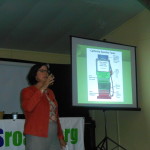
Susan Klassen
When asked what they would do to improve county road conditions the candidates took turns. Pete Foppiano wants to see a change in the way gas tax is distributed stating that the current formula favors counties with high a number of registered vehicles and small road networks. James Gore targeted unfunded pension liability in wanting to reform the county budget but didn’t support new taxes. “I won’t kick the can down the road, because it will probably fall into a pothole,” he said.
Keith Rhinehart said that the idea of spending millions of dollars on cycling routes that affect 1 percent of the commuting public is unconscionable and that he would eliminate bike path construction in favor of road repairs and tax cyclists. Finkelstein reminded Rhinehart that cyclists also drive cars and so pay the same taxes as everyone else. Rhinehart said that he will work as hard as anyone to fix this pension crisis.
Deb Fudge said she is wants to hear the county’s long-term roads plan, which McGuire said would be released within 60 days, and is interested in the $1 billion plus, 20-year project to rehabilitating the entire road network. When she said that it could be paid for by a sales or property tax increase one women in the audience commented, “No way.” Fudge quickly added, “Only with voter approval.” I don’t think Fudge is getting that women’s vote.
Ken Churchill, a longtime advocate of overhauling pensions, said that pensions are costing us money that is not fixing our roads and new taxes are not going to do it. When McGuire said that the county’s pension liability is now about 80% funded, Churchill challenged that figure saying that it’s closer to 60%. McGuire then said that the new actuarial figures backed him up and Churchill admitted that he hadn’t seen the new figures. McGuire went on to counsel the pension hawks saying that even with futures savings it’s not a dollar for dollar deal.

SOS Roads Forum
As the debate/conversation continued to intensify McGuire, as only he would do, decided that everyone needed chocolate so he passed around a basket. Finkelstein spotted Jim Wood, Healdsburg mayor and candidate for the 2nd Assembly district, and ask if he anything to add to the road conversation. Wood said that he didn’t as he was there on a fact finding mission.
Craig Harrison held up a sign that said “Tired of Potholes?” go to SOSRoad.org.” He said anyone who wants a sign should go to the organization’s website which is an excellent resource for information regarding Sonoma County roads. He continued that a statewide pension fix would help improve all nine Bay Area roads. To that end they have filed a “Friend of the Court” brief in the City of Stockton federal bankruptcy case arguing that retirement benefits owed to city workers should not emerge unscathed from a municipal bankruptcy.
All and all it was a fun get-together. The crowd was engaged and even a local climate denier, who kept blurting out “junk science” (about what wasn’t clear), didn’t dull the interchange. Local politics at its best.
Read More
Posted by Michael Haran on May 9, 2014
A few weeks ago I attended the Piner Highs School open house for their new high tech science building. The $3.6 million dollar structure (the full size planetarium is awesome), officially known as the Science Position Astronomy Research Quest Center, or SPARQ, was built to house the schools STEM (science, technology, engineering and Math) classes. To see the new facility go to: http://sparqatphs.com/index.html
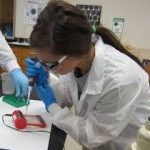
Testing for GMO
I came upon a group of fifteen-year old students at the Health Science and Biotechnology table who were eager to show me how to test a food sample to see if it had been genetically modified. They showed me the micropipette in which the mashed food sample is placed along with a gel solution to separate the DNA from the rest of the cellular components. Simply stated, the DNA then needs to be copied many times because more DNA than is found in the food is needed for testing. This is done through a procedure known as Polymerase Chain Reaction or PCR in which the food DNA is unwound. The last step is to visualize the DNA and see if the DNA has been modified. This is usually done by gel electrophoresis. These students are a lot smarter than I was at fifteen – than I am now for that matter.
To really get into how to test for GMOs go to: http://www.hudsonalpha.org
At lot about GMOs (Genetically Modified Organisms) has been in the news lately and you know the subject is gaining main stream consciousness when a high school STEM course is teaching how to test for the presence of GMOs in their food.

California Prop 32 Campaign Poster
A California initiative, Prop 37, which would have required GMO labeling of all food by retailers and food companies, was defeated last November and California State Senator Noreen Evans is trying to get the job done through the California legislature by introducing a bill requiring all consumer food must contain GMO labeling. In Vermont they just passed legislation (5/8/2014) making the state the first to require food producers to label products made with generic engineering. The law won’t go into effect for two years and producer lawsuits are expected. Vermont Gov. signs GMO Labeling into Law http://radioboston.wbur.org/2014/05/08/vermont-gmo-labeling.
All GMOs are not bad. The GMO process in nature is known as evolution although nature’s process takes considerably longer (thousands and even millions of years) than the man-made kind. Technically GMOs are experimental plants or animals that have been genetically engineered in a laboratory with DNA from other plants, animals, bacteria or virus.
the man-made kind. Technically GMOs are experimental plants or animals that have been genetically engineered in a laboratory with DNA from other plants, animals, bacteria or virus.
There are two main reasons for GMOs. First, seed producers modify their seeds to make them resistant to their brands of herbicides; and second, seed producers modify plants to contain built-in pesticides. Today, GMO ingredients are found in 80% of the packaged foods in the U.S. GMO crops are also added to processed foods as oils and sweeteners.
To make a GMO, three main components are required: the gene you want to transfer, the organism you want to put it into (target species), and a vector to carry the gene into 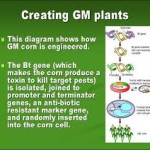 the target species cells. The steps are relatively straightforward, but can be technically challenging. The gene to be transferred (trans-gene) must be cut out and isolated from the original organism. This is usually done by restriction enzymes, which are like molecular scissors that recognize specific sequences in the DNA and cut it at those places.
the target species cells. The steps are relatively straightforward, but can be technically challenging. The gene to be transferred (trans-gene) must be cut out and isolated from the original organism. This is usually done by restriction enzymes, which are like molecular scissors that recognize specific sequences in the DNA and cut it at those places.
To really get into how to make a GMO go to: http://www.hudsonalpha.org
For some, the idea of GMO food is a good because the modifications allow crops to become resistant to drought and infestations, letting more people have more regular meals. Some research even shows that the world produces 17% more food than it needs to produce to provide each current human with three meals per day.

Rats with tumors
Others look at genetically modified foods as dangerous. From allergic reactions to potential intestinal damage, many people wish to avoid GMO foods because of animal studies that have shown changes in internal cell structure, abnormal tumor growth, and unexpected deaths that have occurred.
Another reason people distrust GMO foods is that they are so new to our food chain. People feel that they are the “lab rat” generation for the big Ag companies to see what happens to humans after a generation of eating GMO foods.
If you want to know more about this go to: http://organicconnectmag.com
When it comes to the mass the mass production of GMO foods the benefits need to outweigh the risks. In some areas, having access to GMO foods may make sense because resources are thin and people are dying from hunger. However, in other areas the risks may outweigh the rewards. So what exactly are the pros and cons of genetically modified foods?
Pros of Genetically Modified Foods:

GMO vegetables
1. Better overall quality and taste
Through the modification of foods, the flavors can be enhanced. Peppers can become spicier or sweeter. Corn can become sweeter. Difficult flavors can become more palatable.
2. More resistant to disease

Corn without GMO
Plants and animals that have been genetically modified can become more resistant to the unexpected problems of disease. Think of it as a vaccine for that plant or animal, except that the vaccine is encoded into the genetics instead of a shot given to the immune system.
3. More nutrition benefits
GMO foods can have vitamins and minerals added to them through genetic modifications to provide greater nutritive benefits to those who eat them. This is especially common in developing countries that don’t always have the access to needed resources.
common in developing countries that don’t always have the access to needed resources.
Cons of Genetically Modified Foods
Here are the primary problems with GMO foods:
1. Environmental damage
By growing plants or raising livestock in environmental conditions that normally wouldn’t support them, there is the potential of irrevocably damaging that environment. This is often seen through GMO crossbreeding – weeds, for example, that can be crossed with GMO plants can often become resistant to herbicides, creating the need for more GMO efforts.
2. There is no economic value
GMO foods take just as long to mature and take just as much effort to grow, meaning that there is no real economic value to growing GMO foods when compared to non-GMO foods. In addition, growers have seen little economic gain from the use of GMO crops.
3. A growth in allergic reactions in the general population
 Time and time again, studies have shown that the consumption of GMO foods increases the risks of food-based allergies in people. If someone develops an allergy to soy because of GMO efforts, then if livestock eats that GMO soy as well, that person would have a high probability of an allergic reaction from eating the animal meat. Do the benefits outweigh the risks?
Time and time again, studies have shown that the consumption of GMO foods increases the risks of food-based allergies in people. If someone develops an allergy to soy because of GMO efforts, then if livestock eats that GMO soy as well, that person would have a high probability of an allergic reaction from eating the animal meat. Do the benefits outweigh the risks?
The following is brief timeline of the development of GMO:

In 1935, a Russian scientist, Andrei Nikolaevitch Belozersky, isolates pure DNA.
In 1953, James Watson and Francis Crick publish their discovery of the three-dimensional double helix structure of DNA. This discovery will eventually lead to the ability of scientists to identify and “splice” genes from one kind of organism into the DNA of another.
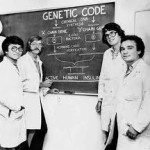
In 1973, the idea for man-made DNA, or Recombinant DNA (rDNA), comes from a grad student at Stanford University Medical School. Professor Herbert Boyer and a few of his biologist colleagues develop it.
In 1975, a group of biologists get together (the Asilomar Conference) with a few lawyers and doctors to create guidelines for the safe use of genetically engineered DNA. 
In 1980, the U.S. Supreme Court rules (5-4) that genetically altered life forms can be patented. The decision allowed the Exxon Oil Company to patent an oil-eating microorganism.
In 1982, the U.S. Food and Drug Administration approved the first genetically engineered drug, Genentech’s Humulin, a form of human insulin produced by E. coli bacteria. This becomes the first consumer product developed through modern bioengineering.
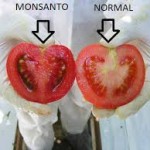
In 1987, the first field tests of genetically engineered crops (tobacco and tomato) were conducted in the United States.
In 1992, the FDA declared that genetically engineered foods are “not inherently dangerous” and do not require special regulation.
In 1994, FDA approves the “Flavr Savr” tomato for sale on grocery store shelves. The delayed-ripening tomato has a longer shelf life than conventional tomatoes.
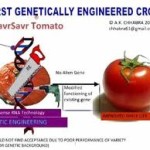
FlavrSavr Tomato
In 1996, weeds resistant to glyphosate, the herbicide used with many GMO crops, are detected in Australia. Research shows that the super weeds are seven to 11 times more resistant to glyphosate than the standard susceptible population.
In 1997, the European Union rules in favor of mandatory labeling on all GMO food products, including animal feed.
 In 1999, Dr. Zhiyuan Gong, at the National University of Singapore, injected a green fluorescent jellyfish gene into a zebra fish embryo, allowing it to integrate into the fish’s genome. The goal was to develop a fish that could detect pollution by selectively fluorescing in the presence of environmental toxins. The fish are now sold worldwide as Glofish.
In 1999, Dr. Zhiyuan Gong, at the National University of Singapore, injected a green fluorescent jellyfish gene into a zebra fish embryo, allowing it to integrate into the fish’s genome. The goal was to develop a fish that could detect pollution by selectively fluorescing in the presence of environmental toxins. The fish are now sold worldwide as Glofish.
In 1999, over 100 million acres worldwide are planted with genetically engineered seeds. The marketplace begins embracing GMO technology.
In 2000,International Biosafety Protocol is approved by 130 countries at the Convention on Biological Diversity in Montréal, Canada. The protocol agrees upon labeling of genetically engineered crops, but still needs to be ratified by 50 nations before it goes into effect.
 In 2003, a Bt-toxin-resistant caterpillar-cum-moth, Helicoverpa zea, is found feasting on GMO Bt cotton crops in the southern United States. In less than a decade, the bugs have adapted to the genetically engineered toxin produced by the modified plants.
In 2003, a Bt-toxin-resistant caterpillar-cum-moth, Helicoverpa zea, is found feasting on GMO Bt cotton crops in the southern United States. In less than a decade, the bugs have adapted to the genetically engineered toxin produced by the modified plants.
In 2011, research in eastern Quebec finds Bt toxins in the blood of pregnant women and shows evidence that the toxin is passed to fetuses.

In 2012, French farmer Paul Francois sues Monsanto for chemical poisoning he claims was caused by its pesticide Lasso, part of the Roundup Ready line of products. Francois wins and sets a new precedent for future cases.
In 2014, Monsanto’s patent on the Roundup Ready line of genetically engineered seeds will end in two years. In 2009, Monsanto introduced Roundup 2 with a new patent set to make the first-generation seed obsolete.
Read More




























